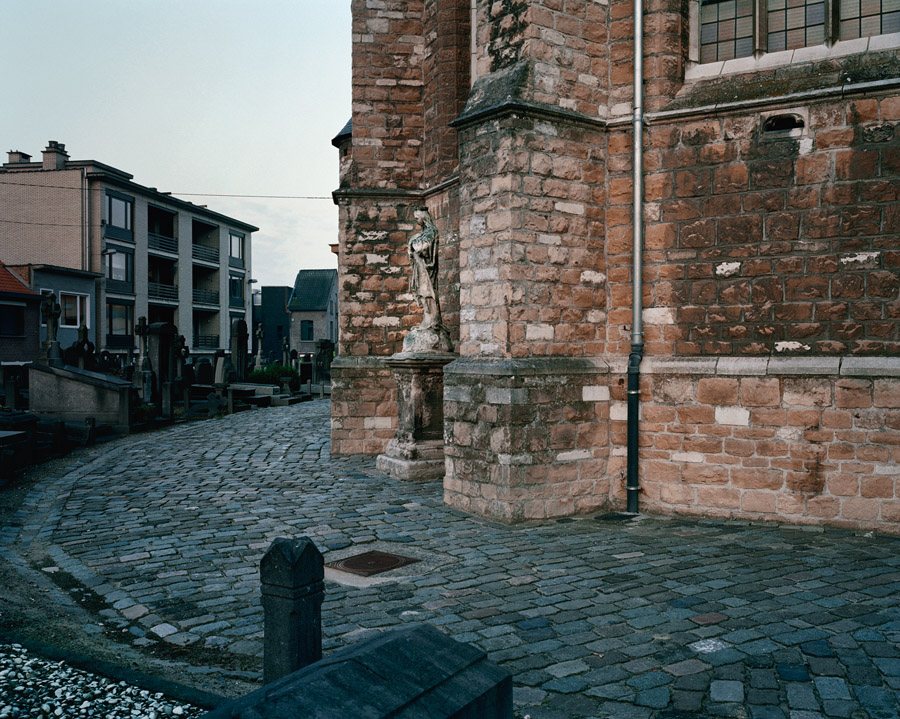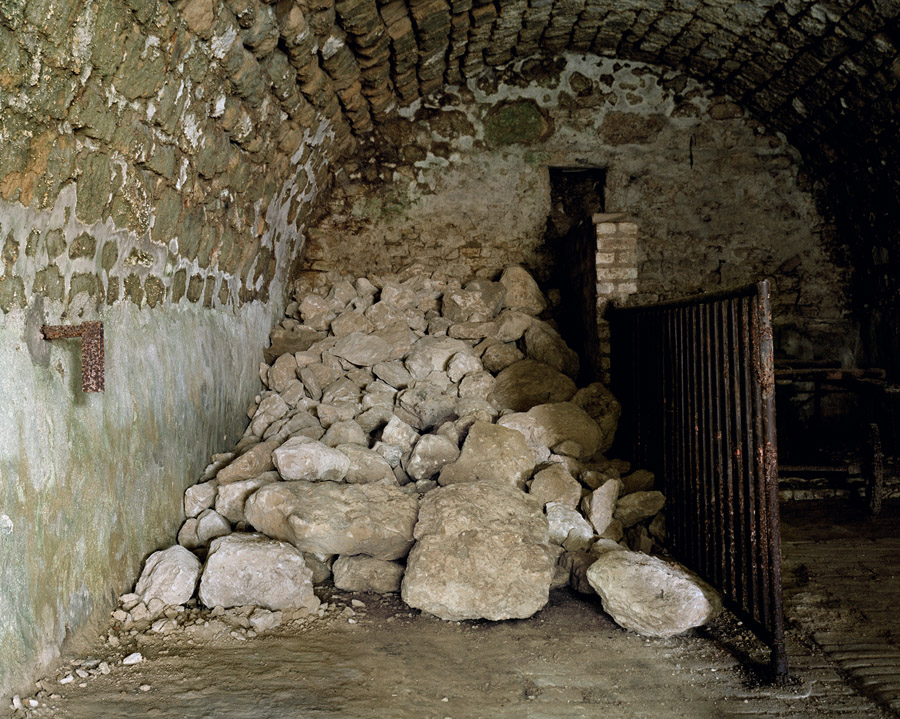
SHOT AT DAWN in Conflict Time Photography, Museum Folkwang, Essen 10 April - 5 July 2015

SHOT AT DAWN
"The number of soldiers in the British army who were executed by firing squads during the First World War is utterly insignificant compared with the massive carnage at the front… At the time of their condemnation [these soldiers] were branded as ‘shirkers’, ‘funks’ and ‘degenerates’, whose very existence was best forgotten. Yet, ever since, the manner in which they were tried and their subsequent treatment have given rise to a profound unease in the national conscience. Death did not come to them, random and abrupt, on the field of battle; it came with measured tread as the calculated climax of an archaic and macabre ritual carried out, supposedly, in the interests of discipline and morale."
Anthony Babington - For the Sake of Example: Capital Courts-Martial 1914–1920
'Shot at Dawn' focuses on the sites at which British, French and Belgian troops were executed for cowardice and desertion between 1914 and 1918. The series comprises twenty-three photographs, each depicting a location at which the soldiers were shot or held in the period leading up to their execution. All are seasonally accurate and were taken as close as possible to the precise time of day at which the executions occurred.
In Britain, the files on soldiers executed for cowardice and desertion were closed to the public until the 1990s. When they were finally made available, it became clear that in addition to the French, Belgian and German armies who shot their own side, around 1,000 men were executed by firing squads between 1914–18. Although this figure is minute in relation to the vast number of casualties on the frontline, the manner in which these soldiers met their end has generated a great deal of controversy. In some cases, shell shock or years of good service weren’t taken into account when verdicts were reached and official pardons have since been granted.
For months Chloe Dewe Mathews researched these cases, trawling through courts-martial documents, using old aerial photographs and monastery diaries to pinpoint the precise locations where each man was executed. Academics, military experts, museum curators and local historians enabled her work and although many of them have dedicated their lives to researching the subject, none have comprehensively visited the sites of execution in such a systematic fashion. Whether slag-heap, back of a primary school, churchyard, town abattoir or half-kempt hedgerow, these places have been altered by a traumatic event. By photographing them, Dewe Mathews is reinserting the individual into that space, stamping their presence back onto the land, so that their histories are not forgotten.
For more information, please see the dedicated project website - http://shotatdawn.photography

Soldat Joseph Pascal, Soldat Lucien Joseph Royer, Soldat Édouard Jules Sayer, Soldat Jean Pierre Soulier, 08:00 / 5.9.1914 Les Rouges-Eaux, Vosges, Lorraine

Soldat Eugène Bouret, Soldat Ernest François Macken, Soldat Benoît Manillier, Soldat Francisque Pitiot, Soldat Claudius Urbain, Soldat Francisque Jean Aimé Ducarre, 06:30 / 7.9.1914 Soldat Jules Berger, Soldat Gilbert Gathier, Soldat Fernand Louis Inclair, 07:45 / 12.9.1914 Vanémont, Vosges, Lorraine

Soldaat Jean Raes, Soldaat Alphonse Verdickt, Time unknown / 21.9.1914 Walem, Mechelen, Vlaanderen

Soldat Alphonse Brosse, Soldat Jean Boursaud, 07:00 / 10.10.1914 Ambleny, Aisne, Picardie

Korporaal Leopald Jean Noel, Time unknown / 18.10.1914 Nieuwkapelle, Diksmuide, West-Vlaanderen

Caporal Paul Henry Floch, Soldat Francisque Durantet, Soldat Pierre Gay, Soldat Claude Pettelet, Soldat Jean Quinault, 07:30 / 4.12.1914 Bunker (holding cell), Vingré, Picardie

Soldat Léonard Leymarie, 16:30 / 12.12.1914 Fontenoy, Aisne, Picardie

Soldat Ahmed ben Mohammed el Yadjizy, Soldat Ali ben Ahmed ben Frej ben Khelil, Soldat Hassen ben Ali ben Guerra el Amolani, Soldat Mohammed Ould Mohammed ben Ahmed, 17:00 / 15.12.1914 Verbranden-Molen, West-Vlaanderen

Soldat Pierre Mestre, 07:00 / 8.2.1915 Adjudant Laurent Casanova, Soldat Fernand Humbert, Soldat Joannès Poizat, Time unknown / 23.3.1915 Soldat Eugène Morelli, Time unknown / 7.4.1915 Soldat Victor Prieur, Soldat Julien Blanc, Time unknown / 25.4.1915 Soldat Alexandre Martineau, Soldat Clotaire Lamidé, Time unknown / 3.8.1915 Soldat Célestin Petit, Time unknown / 1.9.1915 Canonnier Joseph Perret, Time unknown / 7.9.1915 Husseren-Wesserling, Haut-Rhin, Alsace

Private Joseph Byers, Private Andrew Evans, Time unknown / 6.2.1915 Private George E. Collins, 07:30 / 15.2.1915 Six Farm, Loker, West-Vlaanderen

Soldat Lucien Jean Baptiste Bersot, Time unknown / 13.02.1915 Fontenoy, Aisne, Picardie

Private Herbert Chase, 04:30 / 11.6.1915 Sint-Sixtusabdij, Westvleteren, West-Vlaanderen

Private Bert Hartells, Private John Robinson, Private Alfred D. Thompson, Private Ernest Fellows, 04:00 / 26.7.1915 Dikkebus, Ieper, West-Vlaanderen

Private James Graham 07:22 / 21.12.1915, Private John Docherty 07:12 / 15.02.1916, Private John Jones Time unknown / 24.2.1916, Private Arthur Dale Time unknown / 3.3.1916, Private C. Lewis Time unknown / 11.3.1916, Private Anthony O’Neill Time unknown / 30.4.1916, Private John William Hasemore 04:25 / 12.5.1916, Private J. Thomas Time unknown / 20.5.1916, Private William Henry Burrell Time unknown / 22.5.1916, Private Edward A. Card Time unknown / 22.9.1916, Private C. Welsh Time unknown / 6.3.1918, Former abattoir, Mazingarbe, Nord–Pas-de-Calais

Private James Crozier, 07:05 / 27.2.1916 Le Domaine des Cordeliers, Mailly-Maillet, Picardie

Second Lieutenant Eric Skeffington Poole, 07:25 / 10.12.1916 Town Hall (prison cell), Poperinge, West-Vlaanderen

Soldat Lucien Baleux, Soldat Émile Lherminier, Soldat Félix Louis Milhau, Soldat Paul Regoult, Time unknown / 23.5.1916 Roucy, Picardie

Private William Bowerman, 05:40 / 24.3.1917 Fosse n° 4, Ferfay, Nord–Pas-de-Calais

Soldat Casimir Canel, Soldat Jean-Louis Lasplacette, Soldat Alphonse Didier, 05:00 / 12.6.1917 Cellar (holding cell), Maizy, Picardie

Caporal Joseph Dauphin, Soldat Arthur Nicolas Renauld, 05:50 / 12.6.1917 Ferme Faite, Ventelay, Champagne-Ardenne

Private Frederick Loader, Time unknown / 15.8.1917 Kasteelmolen, Reningelst, West-Vlaanderen

Private William Smith, 06:30 / 14.11.1917 Primary school, Reningelst, West-Vlaanderen

Private Henry Hughes, 05.50 / 10.4.1918 Klijtebeek stream, Dikkebus, Ieper, West-Vlaanderen

SHOT AT DAWN in Conflict Time Photography, Tate Modern, London, 26 November 2014 - 15 March 2015

SHOT AT DAWN at Irish Museum of Modern Art, 9 October 2015 – 28 March 2016

SHOT AT DAWN at Irish Museum of Modern Art, 9 October 2015 – 28 March 2016

SHOT AT DAWN at Irish Museum of Modern Art, 9 October 2015 – 28 March 2016

SHOT AT DAWN at Irish Museum of Modern Art, 9 October 2015 – 28 March 2016

SHOT AT DAWN at Irish Museum of Modern Art, 9 October 2015 – 28 March 2016

SHOT AT DAWN at Stills: Scotland’s Centre for Photography, Edinburgh 8 November 2014 - 25 January 2015

SHOT AT DAWN at Stills: Scotland’s Centre for Photography, Edinburgh 8 November 2014 - 25 January 2015

SHOT AT DAWN at Stills: Scotland’s Centre for Photography, Edinburgh 8 November 2014 - 25 January 2015

SHOT AT DAWN at Stills: Scotland’s Centre for Photography, Edinburgh 8 November 2014 - 25 January 2015

SHOT AT DAWN at Stills: Scotland’s Centre for Photography, Edinburgh 8 November 2014 - 25 January 2015



































